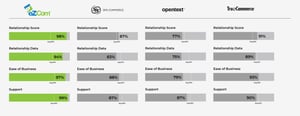Grow Revenue — Online or In-Store
Whether you have an online store powered by Shopify, Magento or WooCommerce, or you use EDI to trade with brick-and-mortar retailers, you want email marketing that works.
Email is a marketing tactic that is proven effective. While it may seem like yesterday’s technology, email remains a great way to convert contacts into customers. But it’s critical to handle the process well. Not only is it disappointing if you invest time and resources in email campaigns that fail to produce results, you can actually turn off customers with poorly planned approaches.
While it’s hardly inclusive, our list of 16 Best Practices for Email Marketing is a great place to start.
1) Build your list.
This is Number One because, well, it should be Step One. If your email marketing is going to be successful, you’ll need to make sure you’re sending it to the right people. It’s a good idea to start out by growing your list organically. Ask customers for their email addresses — a special discount when they provide it never hurts. For many suppliers, buying a list of potential new customers also makes sense. Just make sure that any list you buy delivers real subscribers and not simply a high price tag.
2) Make it easy for people to provide email addresses.
People are already reluctant to provide their email addresses so don’t make it any harder than necessary. Nobody should be asked to do more than type in their email address and hit Return.
3) Choose software that makes sense for your business.
Automating email marketing is critical but you’ll face all kinds of choices when it comes to selecting email marketing software. Analyze them — Constant Contact, mailchimp, sendinblue are just a few of the many options out there. Newer applications like SendyBay can be especially cost-effective for Amazon sellers who have large subscriber bases and need to send bulk newsletters. What’s important is that you’re honest about your current needs and consider how well the software will scale as your business grows. How regularly will you be sending messages? How big is your list? Do you expect to scale up this aspect of your marketing? Use these kinds of questions to guide you.
4) Make sure you have an effective Cart Abandonment email.
Somebody strolls into your store, fills up their cart with a bunch of items, and then ditches it right by the cash register. If you were the manager, would you ask them about it? Wouldn’t you love to at least know why they didn't buy? Sending an email when online shoppers don't make it through the checkout process will sometimes remind them to finish the task. Even if they don’t buy, you might wind up getting a response with insights that could help improve your business.
5) Avoid the hard sell. Embrace education.
Nobody likes to open their email and find an over-the-top sales pitch. Think about the very nature of email — it facilitates an easy exchange of information. But it also starts as a one-way conversation because you're sending a message to someone who didn't specifically request it, even if they're a subscriber. Soften that. Provide news, offer tips that will help a customer get the most out of your products, or simply make a customer feel good about their interest in your brand. There are a lot of ways you can make a sale that don’t require asking for it right away.
6) Don’t forget a call to action.
Avoiding the hard sell doesn’t mean you should be afraid to ask the recipient to do something. Take advantage of special offer, request a free assessment, share a message with a friend — anything that prompts action will help you get maximum value from your message.
7) State your purpose quickly. Like in the first two sentences.
In conversation, nobody likes the person who takes forever to arrive at their point. Same thing with the readers of your email. They are whipping through their In Box, and time is precious. If they don’t know why you’re reaching out to them in the first few seconds they spend reading your message, their twitchy finger is going to hit Delete.
8) Sweat the Subject line.
If you don’t really work on your Subject line, there’s a good chance you’re wasting everything that comes after it. It’s the first thing people will see and if it’s not either intriguing, informative, funny or interesting—better yet, make it all of those things—your reader isn’t going to want to keep going. If you’re having trouble with a great one, look up lists of Subject lines that are considered great. Don’t just copy one— read them to spark ideas for your own.
9) Write your content for the interests of your audience. Not your own.
Even if the marketing team is excited about a new product or an added feature, temper that enthusiasm with an understanding of how your audience might actually feel about it. Make sure you focus on the benefits it provides them and not, say, how long your company has been working on it.
10) Add a P.S.
You should avoid using it every single time — a bit gimmicky — but using a Post Scriptum in some of your emails is an effective tactic. Remember when you were a kid and you saw a letter with a P.S.? And you read it first? The same thing happens with adults.
11) Keep it as short as possible. No, wait. Shorter.
Mark Twain once began a correspondence with, “I’m sorry this letter is so long. If I’d had more time, it would be shorter.” Or something like that. He probably wrote it more efficiently. The last thing your customers want to get in their email is something that looks like homework so keep your emails brief and make every word count.
12) Monitor your bounce rate.
There are all kinds of bounces with email marketing. A hard bounce is when a customer unsubscribes. A really hard bounce? That’s when your ESP is blocked because your messages are considered low quality and spam-like. A soft bounce? Well, to us, that’s when the person who received your email didn’t bother to open it.
13) Test every time.
No matter what anyone says, nobody is 100% right when it comes to email marketing. You may think you have an email that’s a true winner, but when you look at the Open rates, you’re disappointed. Or you might not be happy with one but find it performs amazingly well. That’s why you should do A/B testing. Make sure the emails are different in style and tone but similar in message. If you send a similar message to different lists, establish a Control email — that’s the one that has performed the best in the past. With A/B Testing, you won’t be replying on instinct to figure out what works with your audience — you’ll have data that proves what works and what doesn’t.
14) Establish goals.
Before you launch your email campaign, make sure you have a clear picture of what you want to achieve. Are you trying to get customers to take advantage of an offer? Are you hoping to build your subscriber list for the future? Do you want to generate contact between a potential client and a salesperson? It seems obvious, but starting with a clear agenda helps ensure that your messages are pointed and effective.
15) Make it easy for people to unsubscribe.
You might think that making it difficult for people to remove themselves from your email marketing mailing list is an advantage. But all this does is create animosity — never a good thing for your brand — and might even cause someone to report you as a spammer. While you don’t want people to unsubscribe, you don’t want them to resent you either. Scrub your list regularly and avoid irritating people who still may wind up as customers one day.
16) Don’t call it a newsletter in your Subject line.
Yes, even if that’s precisely what it is. Fact is, nobody every rushed to their mail box because they couldn’t wait to sit down and read that newsletter. If you insist, you can call it a Newsletter once they open it — just make sure you don’t do that in the Subject line.
Remember that while this list is a good one, it’s not exhaustive. There are countless other good practices for email marketing that you’ll want to consider and things are changing every day. Stay on top of the likes and dislikes of your customers and pay attention to shifts in the way people use technology. Do it well and email marketing is a cost-effective way to boost sales and grow your brand.
Do you have ideas for email marketing that you would like to share? We’d love to hear them.






